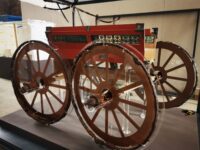 The exceptional ceremonial carriage discovered in the Pompeiian suburb of Civita Giuliana in 2021 has been restored and placed on public display for the first time.
The exceptional ceremonial carriage discovered in the Pompeiian suburb of Civita Giuliana in 2021 has been restored and placed on public display for the first time.
While other carriages and carts have been found in Pompeii, this one is unique in Italian archaeology because it was a pilentum, a vehicle used by the elites for ceremonial occasions. Livy wrote that the senate granted Roman matrons the right to drive to sacred festivals and games in the pilentum in recognition of their donation of gold and jewelry to the treasury after Marcus Furius Camillus’ defeat of Veii in 396 B.C.
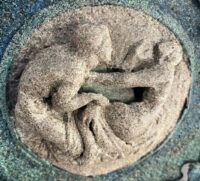 The chariot is adorned with bronze and silver medallions decorated with reliefs of explicit erotic scenes, cupids and female figures. Archaeologists believe it was used to transport a new bride, and perhaps her mother or mother-in-law, to her marital home after the wedding. It has therefore been dubbed the Bride’s Chariot.
The chariot is adorned with bronze and silver medallions decorated with reliefs of explicit erotic scenes, cupids and female figures. Archaeologists believe it was used to transport a new bride, and perhaps her mother or mother-in-law, to her marital home after the wedding. It has therefore been dubbed the Bride’s Chariot.
Its condition and preservation make it one-of-a-kind too. Its iron wheel rims, bronze cladding, tin and 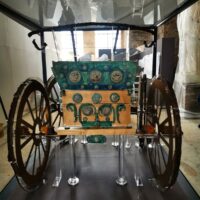 silver decorations, the iron framework of the back seat, even the wood wheel hubs that were mineralized by the volcanic ash, survived. The carriage was painstakingly excavated by the experts from the Archaeological Park of Pompeii, specialists in the preservation or wood as well as metals. At every stage, whenever they encountered a void they filled it with plaster and made a cast of the space decomposed organic material had once occupied. Therefore, the parts of the chariot that did not survive — the axle, the platform, the ropes, the vegetal decorations — were able to be recreated from the casts.
silver decorations, the iron framework of the back seat, even the wood wheel hubs that were mineralized by the volcanic ash, survived. The carriage was painstakingly excavated by the experts from the Archaeological Park of Pompeii, specialists in the preservation or wood as well as metals. At every stage, whenever they encountered a void they filled it with plaster and made a cast of the space decomposed organic material had once occupied. Therefore, the parts of the chariot that did not survive — the axle, the platform, the ropes, the vegetal decorations — were able to be recreated from the casts.
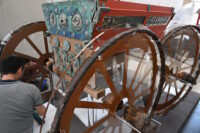 The carriage has now been reconstructed with modern materials like plexiglass and wood standing in for the lost parts. The surviving original elements have been integrated into the reconstruction.
The carriage has now been reconstructed with modern materials like plexiglass and wood standing in for the lost parts. The surviving original elements have been integrated into the reconstruction.
The reconstructed pilentum is part of a new exhibition at the Baths of Diocletian that explores the our relationship with classical antiquity as seen 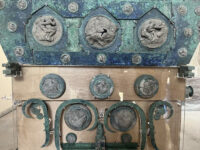 through millennia of cultural, intellectual and artistic transmission. The plaster casts of two victims of Vesuvius found in the same luxury villa as the carriage are also part of the exhibition, as is the Hercules figure recently found at the Appia Antica Archaeological Park. The Instant and Eternity: Between Us and the Ancients exhibition runs from May 4th through July 30th.
through millennia of cultural, intellectual and artistic transmission. The plaster casts of two victims of Vesuvius found in the same luxury villa as the carriage are also part of the exhibition, as is the Hercules figure recently found at the Appia Antica Archaeological Park. The Instant and Eternity: Between Us and the Ancients exhibition runs from May 4th through July 30th.
Axle not axel!
“Livy wrote that the senated grated Roman matrons the right ..”
Eh?
Senate granted …
Beautiful reconstruction.